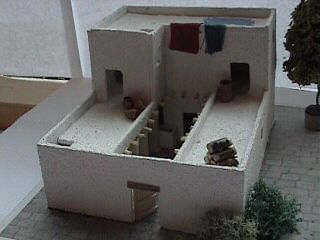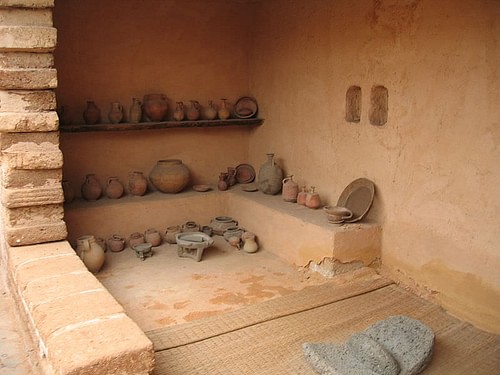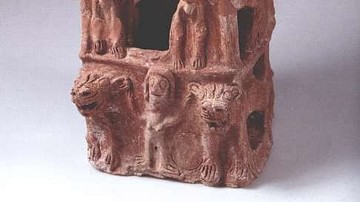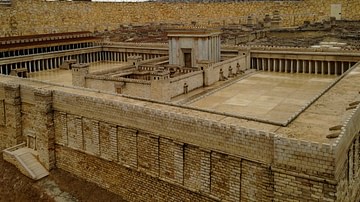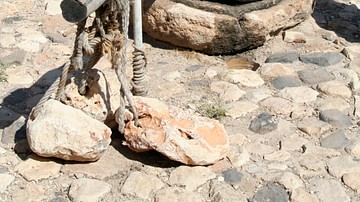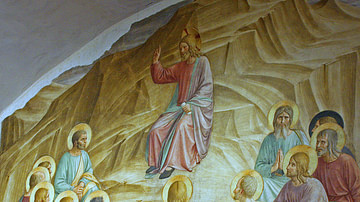The process of determining ethnicity is a problematic venture, even more so when interpreted through the archaeological record. Despite this issue, evidence, such as the four-room house, has been preserved that can be interpreted to represent ethnic markers and help illuminate the lives of individuals and groups from the past. Following the theoretical perspective of Fredrik Barth, ethnicity is understood to be a malleable and self-ascribed phenomenon within a particular group. In light of this, the artifacts found within the archaeological record have the ability to illustrate how a particular group identified itself and how it perpetuated this identity. I propose to demonstrate this act of self-ascription and perpetuation of ethnic identity through an examination of ancient “Israelite” architecture, namely four-room houses during the Iron I and Iron II periods of the central highlands. This analysis will include an interpretation of the structure, function, and origin of the four-room house, as well as a cross examination with biblical passages suggesting possible Egyptian parallels as well as an egalitarian lifestyle.
Determining Ethnicity
The definition and interpretation of ethnicity has evolved over the last century and new methods and perspectives have been adopted. This shift occurred in the late 1960s with the work of Fredrik Barth. Barth sparked this evolution with the hypothesis that ethnicity is malleable, can vary, be learnt, and change. Prior to this interpretation, theorists such as Durkheim and Weber understood ethnicity to be static, an understanding that continued until the late 1960s CE. According to Barth, ethnic groups are a form of social organization that is constructed in response to self-ascription and the ascription of others. In other words, an ethnic identity is formed through a group's understanding of itself as an ethnic group, as well as how others outside the group understand them. This self-understanding is accomplished through self-identification, a process that often includes a conscious construction of identity by the group. This may be influenced by factors such as individual psychology, relationships, family, community, nation, and so on. Geoff Emberling argues that the process of self-ascription is likely the most “fundamental characteristic of ethnicity,” stressing common genealogy and cultural construction as key factors. [Emberling, 302] Key to both Barth and Emberling's concept of ethnicity is the emphasis of “social facts” rather than biological, meaning that ethnicity is more than a simple “genetic relatedness.”[Emberling, 302]
If an ethnic group is not simply determined according to genetic relatedness then other determinative factors must be considered; these include, but are not limited to: language, religion, cuisine, clothing, household objects, and architecture. For the purposes of this paper, however, architectural remains will take precedence over the other factors simply due to the focus on four-room houses and the identification of ethnicity through architecture.
Returning to the process of self-ascription, Elizabeth Bloch-Smith begs the following questions: what shared interest forged the bond of Iron I Israel, and what shared institutions perpetuated group identity? Contrary to her analysis of the subject, I suggest the development and use of the four-room house as a possible solution to both questions. The four-room house represented more than a simple domestic dwelling type; it represented ideological and ethnic behaviours that were expected and required by those that utilized it. Granted, biblical sources appear to omit the significance of house plans, but this is not to say that significance was totally absent. Biblical sources represent one resource; they are not the ultimate judges of fact, and they most certainly do not represent the most historically accurate source; however, Bloch-Smith's critique does bring attention to the issue of incorporating biblical archaeology with biblical scholarship. Although the two depend on one another to a certain degree, the process is far from simple.
As Emberling notes, the issue for the archaeologist determining ethnicity is the identification of objects and characteristics that were socially meaningful. As the debate among scholars suggests, uniform consensus is far from existent in the interpretation of the four-room house as an ethnic marker and the same can be said for other determinative factors. This issue of interpretation is addressed by Ziony Zevit who argues for a greater attempt toward objectivity in scholarship, particularly within biblical studies and biblical archaeology. Essentially, Zevit stresses the impact of one's worldview upon his or her behaviour. A student or scholar of the past must recognize her own preconceived worldview in order to bracket out such standards that may be incompatible with the subject of study. In other words, it is problematic for an individual of the 21st century to differentiate between what was, and was not, meaningful in antiquity, and it is quite possibly this process that creates debate among scholars in this subject area. With this in mind, however, one may proceed to interpret the archaeological evidence while simultaneously taking the problematic nature and consciously bracketing one's own worldview into consideration.
In light of this discussion, a definition for ethnicity has yet to be provided in order to clarify my purpose. Eloquently put, Norman K. Gottwald describes the term ethnicity as “a clearly articulated shared identity within a population group, attested by claims of common history, culture, and values.” [Gottwald, 29] In response to this definition, the term ethnicity will be utilized here in reference to the group identity that has been constructed by the group in response to ecological, political, socio-economical, and/or religious factors. It is also in relation to their collective memory and collective identity as understood by itself and by those outside the group. Basically, ethnicity is to be understood as consciously constructed rather than merely biological inherited, and is not only self-ascribed but ascribed by others.
The group in question here, namely the early Israelites, provides an interesting case for the interpretation of ethnic identity. Although the origins of the Israelites in Canaan are not the focus of this paper, it is important to note the ambiguity of their arrival to the region as well as the largely contested interpretation among scholars. Popular theories include the pre-existence of Israelites in Canaan, suggesting that the material evidence does not support the arrival of a new semi-nomadic people; this is in contrast to the alternate theory in which the influx of rural settlements during the early Iron I period is interpreted to represent the arrival of a new cultural or ethnic group. Not wanting to give preference to one theory over another, I propose a more intermediate solution.
As the end of the Bronze Age and late 13th century BCE represented a turbulent time throughout the ancient Mediterranean world, it is entirely possible that a variety of peoples settled in the central highlands of Canaan. William G. Dever suggests a similar argument in that the “Proto-Israelites” were not homogeneous from the beginning. Instead, the members of this group may have included displaced Canaanites, urban refugees, migrant farmers, Shasu-like Bedouin, and so on. Assuming this was the case, over time a unified group and ideologies would have developed in response to a new self-awareness as has been the case in other similar situations. This seems like a highly plausible situation, especially considering the socio-economic situation during this period such as the destruction and abandonment of various Canaanite urban centers and the possibility that various groups (not exclusive to the displaced urban dwelling Canaanites) may have chosen to settle in the highlands. Not only does this situation seem reasonable, but it seems ridiculous to assume only one group either chose or were permitted to settle in this area, especially due to its adaptability to subsistence farming. However the Israelites arrived in the central highlands, it is the representation of newly found ideologies and self-awareness that is most important to this discussion and it is through the analysis of the four-room house that these constructs can be interpreted.
Four-Room House Structure
The use of the term “four-room house” should be prefaced with an explanation. In the context of this paper the “four-room house” of the central highlands is not limited to domestic dwellings with four rooms alone. As a matter of fact, such houses may have three, four, or more rooms. It is also important to note that pillars are not always present either. Despite these discrepancies, the term “four-room house” is preferred over the alternate “pillared courtyard house” or “Israelite house” due to the problematic nature of labeling them as “Israelite houses” without more direct evidence to prove that the houses were used exclusively by Israelites.
The typical layout of the four-room house consisted of a rectilinear plan divided into three, four, or more spaces/rooms. A larger central space was separated by one or two rows of stone pillars, with an entrance that led from an exterior courtyard into the central space. Additional rooms may be added or subdivided, but the basic plan follows the description above. A deep cistern was often included in the courtyard, as were clay or mud brick ovens and hearths for cooking. This suggests that the majority of domestic tasks were performed outdoors, especially as the side rooms were often utilized for livestock as is suggested by the existence of cobbled floors, or as storage space. Both single, double, and possible triple, storied structures have been uncovered, supporting the theory in which the inhabitants slept and ate in the upper story, separated from the animals.
The structure would have possessed a flat roof, optimal for drying foodstuffs and additional storage, although one of the long rooms, usually the one in the center, may have been unroofed. In terms of protection the community generally seems to have possessed a perimeter wall. Such walls are not to be confused with a defense system; on the contrary, as with the over three hundred courtyard houses excavated, no defense walls were identified. Both Dever and Killebrew describe the oval settlement of four-room house communities, explaining that the design creates a perimeter wall utilizing the buildings themselves. Quite simply, defense does not appear to have been a priority of the four-room house inhabitants, as is expressed through the lack of weapons, sudden destruction or burning discovered. Instead, the perimeter wall suggests that the inhabitants drew their livestock within the walls in the evening so as to protect them from other animals or marauders.
Food remains and animal bones suggest that the communities consisted of farmers and stockbreeders, with enough storage space for their goods to suggest that they were self-sufficient. Additionally, evidence of household facilities for making stone and flint tools, potters' workshops, olive and grade processing installations, loom weights, etc. have been excavated further supporting the self-sufficiency theory, while also demonstrating that the society consisted of small family holdings, representing a kin-related, closely-knit group. Interestingly enough, Dever emphasizes the parallel between the identification of these communities as kin-based to the biblical tradition, supporting the “Israelite” origin theory. In addition, another interpretation of this material defines the community as egalitarian or communitarian, again drawing parallels to Israelite society and its egalitarian character, a concept to be interpreted in more detail later on.
An additional interpretation of four-room house remains includes the identification of public or monumental structures. Both Killebrew and Faust attest to the lack of such structures, while Dever suggests that the four-room house plan was adopted for public structures of various sorts. Once again the issue of interpretation comes to the front. Who is overlooking or omitting evidence, and who is correct? The dominant opinion within secondary sources suggests greater legitimacy for a lack of public structures, but the mere existence of an alternate theory deserves recognition and consideration. Without access to the original excavation reports, and from a total outsider's perspective, the truth may not be attainable. Herein lies the ever-present conundrum of archaeology and scholarship; all that is possible to determine are theories, never fact.
It is possible, however, to determine the chronology of the structure. First appearing in the central highlands in the late thirteenth- early twelfth centuries BCE, the four-room house developed in response to environmental and socio-economical needs. Although originally adopted for its functional qualities, the design of the four-room house would not “crystallize,” or become more uniform, until the later twelfth-eleventh centuries BCE.[Killebrew, Biblical Peoples, 82] Ann E. Killebrew suggests that this crystallization represents something other than selection due to functionality. Instead, the development of a uniform four-room house suggests that the inhabitants chose the design as the result of ethnic behaviour. This concept of ethnic behaviour or group identity influencing a group's actions is not limited to the four-room house in the central highlands. In fact, Peter J. Burke and Jan E. Stets stress the importance of identity of a group and “how their identities influence their behaviour, thoughts, and feelings or emotions.”[Burke & Stets, 3] Simply put, the selection of the four-room house as the uniform dwelling structure was not an accident and was not limited to functional purposes.
The use of four-room house was the result of conscious selection on behalf of the group, a group that may have originated in Canaan or emerged from elsewhere. Either way, the popularity of the four-room house during the Iron Age represents a deliberate choice on behalf of a distinct ethnic group reflecting their ethnic behaviour and needs. Faust demonstrates the relationship between the architectural design and the group identity where he claims:
Four-room houses, by the very uniformity of their plans, the egalitarian ethos reflected by them, and their dominant position within the society discussed, were used to reinforce the community's values and ideology, and to strengthen the sense of togetherness of the population.
The four-room house type was certainly not the only style that was functional for the environment of the highlands, and it was certainly not the only one available during this time period. The four-room house served more than functional purposes; it served ideological and social purposes as well. Put quite simply once again, the selection and use of the four-room house occurred because of a collective decision made by the group in response to their ethnic behaviour.
Socio-ECONOMIC Influence
Quite separate from scholars such as Shlomo Bunimovitz, Dever, Faust, and Killebrew, Finkelstein is a strong supporter of the emergence of the four-room house as a result of socio-economic conditions. This is not to say that the aforementioned scholars completely disregard this theory, however, they argue that the uniformity and survival of the structure for over six hundred years suggests something more complicated. Although I agree with this argument, the interpretation of socio-economic conditions still requires attention in order to gain a better understanding of the context in which the four-room house was developed.
If we accept the theory that the four-room house originally developed in response to socioeconomic conditions, and we also accept the theory that the inhabitants of the central highlands were primarily subsistence farmers and herders, then an examination of the environmental conditions will prove useful in interpreting the evolution of four-room houses. Unfortunately, “we cannot paint a truly realistic landscape of the area in the Bronze and Iron Ages, because archaeologists have rarely recorded evidence useful for reconstructing the ancient environment.”[Stager, 4] Stager creates a bleak picture, but he goes on to theorize that the soil of the central highlands likely resembled terra rosa, the most common soil in the Mediterranean world. This soil is described as shallow, but fertile and agricultural production began as early as 1200 BCE with the appearance of terraces, therefore, suggesting that the central highlands were ideal for cultivation and habitation, easily proven by examining the number of settlements during the Iron Age.
As we have already investigated the structure of this house type, the dwelling layout can be readily interpreted as practical for farm life. In fact, like Finkelstein, Stager suggests that it was the successful adaptation of the four-room house to farm life that was the first and most important feature of the building, a concept that is also supported by Bloch-Smith suggesting that the structure of the four-room house “favors function rather than an ethnic rationale.” [Bloch-Smith, 44] Of course, the four-room house is interpreted as ideal for farm life, and rightly so. But for Stager, Bloch-Smith, and Finkelstein to disregard a deeper significance seems nothing short of problematic.
Finkelstein and Neil Asher Silberman justly argue for the difficulty of distinguishing between “expressions of status and manifestations of ethnicity,” asking how an individual can determine what is a stylistic choice and what is an ethnic marker.[Finkelstein, 203] This sort of issue has been addressed earlier with the problem of interpretation and bracketing one's worldview. Quite frankly, aside from the biblical texts, which were written and compiled much later by a “restored Judahite community” in response to disruption and dispersion of both communities and traditions,[Gottwald, 38] there is a complete lack of written material regarding the highlands during the Iron Age. Finkelstein also emphasizes the lack of cemeteries and grave goods, typically significant sources for determining cultic and religious practices in addition to temples, sanctuaries, and shrines, all of which are also absent. Without such evidence, the ceramic tradition, architectural tradition, and foodways are all that remain for investigation, making the interpretation of a group's identity much more complicated.
Taking issue with Dever who suggests that the four-room house of the “Israelites” was adopted from the lowlands, Finkelstein argues that the only Bronze Age house that can be identified as a proto-type of this house is found in Tel Batash. Granted, this is certainly contradictory of Dever's theory, yet afterwards he offhandedly dismisses the connection between the four-room house and an ethnic group, arguing that the adaptation of such a structure is simply due to the “socioeconomic condition of their inhabitants and the need to adapt to the hill environment.”[Finkelstein, 201] This argument would carry more weight if evidence or further discussion was provided to support such a close-minded claim; however, as it stands Finkelstein presents himself as a scholar with limited vision. That being said, Finkelstein is not entirely incorrect in his theory; he is simply focusing his argument too narrowly. Bunimovitz, Dever, Faust, and Killebrew all support the socio-economic origin of the four-room house type; this is never disputed. Yet to argue that the structural type that survived for so many centuries served only a socio-economic function and no other is certainly illogical.
Quite simply, to argue that the four-room house held no greater significance than utilitarian and agricultural purposes is negligent. The manner in which scholars such as Finkelstein address the concept of interpreting ethnicity through the archaeological record is clearly predetermined, as if no attempt to investigate the concept has or will be made. In fact, there is one simple question that Bunimovitz and Faust address that may prove most useful for those such as Finkelstein: if the four-room house was so suitable to peasant life or subsistence farming, then why was it discontinued following the destruction of the First Temple and the Neo-Babylonian and Persian periods? There is no evidence for significant changes in subsistence patterns after the 6th century BCE, so could this house type represent the “Israelite house” as suggested by Dever, perhaps discontinued after the Babylonian Exile in addition to the other reforms of the time? At this point in time there is not enough evidence to confirm or disprove this theory, but it is certainly an issue that scholars interpreting four-room houses should address.
The four-room house should not be completely disregarded as a possible ethnic marker. In fact, Emberling suggests that a household structure has the ability to be “methodologically valuable because of its close, meaningful relationship to daily life,”[Emberling, 325] Carol Meyers argues that the house represented the “most important locus of economic production and social interaction in traditional societies,”[Meyers, 427] and even Stager claims that the “'house(hold)' was at the center of ever-widening social spheres.”[Stager, 22] Granted the latter was in reference to the family or individuals within the dwelling structure, yet the principle remains the same; the house was and can be understood to be socially significant.
Through this perspective it is entirely practical to interpret the four-room house as an ethnic marker because of its direct relationship to the daily life of members within an ethnic group. This is argued through the understanding that the four-room house served as a physical representation of a communal or ethnic identity that was expressed through mutually understood symbols within the group. The four-room house was the creation of a built environment, it did not occur by accident and must be understood to exist in response to social divisions as well as environmental or economic. Granted, Finkelstein and Stern do not argue against the theory that four-room houses should be understood as a result of social circumstances, but they do not argue in favour of it either. As a matter of fact, they appear to completely overlook several social factors as if none of which are factors in the formation of an ethnic identity.
As mentioned previously, MacKay presents psychology, relationships, family, community, nation, etc. as influential factors for the identification of ethnicity. I propose to adapt this list to include more specific social divisions such as gender, generation, and rank as suggested by Bunimovitz and Faust, as well as religion or cult. All of the factors listed here possess the capacity to influence the development of domestic structures and society more generally, as is suggested by Finkelstein and Stager; yet such factors are also capable of influencing a groups understanding and identification of itself. In other words, what scholars such as Finkelstein and Stager appear to misunderstand, or disregard, is the significance of the influence that social divisions may hold over domestic architecture.
Concepts such as gender, generation, rank, and religion are readily interpreted as influential factors in the development of a group of society, they can also be understood as influential to the creation the group's identity. Why, then, is it so unreasonable to assume that a group's collective identity would be reflected in the architectural traditions, especially one that endured for such a long period in a crystallized or uniform state? Granted, environmental and economic influences must be considered when interpreting architectural traditions, but they are not the only resources available nor should they be the only ones considered.
Egalitarian & Purity Functions
When describing the structure and possible function of the four-room house, an egalitarian community similar to the society within the biblical tradition appears to be expressed. As this theme surfaces in a variety of scholarly sources it deserves special attention and so we shall examine it more closely here in addition to purity concerns. Aside from the evidence that suggests the communities composed of four-room houses to have been self-sufficient, the layout of the house tells us much more. Yes, the communities appear to have been self-sufficient, but they also appear to have demonstrated egalitarian or communitarian values, and purity values as well.
Beginning with the egalitarian values, this concept is expressed through the “tree-like” shape of the plan as described by Bunimovitz and Faust. This plan allows for immediate accessibility from the central courtyard to any room in the house, a concept in direct contrast to contemporary houses in northern Israel such as Tell Keisan, Tel Qiri and Tel Hadar. In these contemporary houses, the plans require the inhabitant to enter each room in a particular sequence suggesting a hierarchical nature. This is relatively absent from the four-room houses of the central highlands, with the exception of subdivision of rooms among the rural and elite. Even this, however, is limited due to the lack of depth in the house and simplicity of the layout.
So can the lack of depth or access hierarchy truly represent an egalitarian society? Determining the solution to such a question is problematic, but the evidence suggests that it may. In this situation the biblical text may prove beneficial, although it is important to utilize it cautiously. The biblical text serves as an excellent resource in regards to the social life of the ancient Jewish, or Judean, population, but it must be understood to be the memories and interpretations of “historical” events and group identity through the eyes of a generation that existed much later than the events in question. With this in mind, the egalitarian nature of the ancient Israelites as expressed by the later authors, may represent a legitimizing myth, or even worse, fabricated history.
Returning to the archaeological remains, perhaps the four-room house does not represent the egalitarian nature as described in the biblical text. As a matter of fact, the variance of house sizes supports this theory suggesting the existence of both poor and rich households; however, in a somewhat complicated manner the biblical text supports the construction of the egalitarian value of the four-room house. If the biblical text is understood to represent a later interpretation or “legitimizing” mythology of Israelite identity, then the apparent egalitarian quality found within the four-room house can also be interpreted as a symbolic form of Israelite identity. Essentially, both the biblical text and the four-room house represent a conscious effort by the community to express a particular quality. The fact that an effort was made suggests that this quality in question was both important to the community and attested by those outside of it, possibly demonstrated through the appearance of varying house sizes. In other words, there was a reason behind the need to express this concept of identity in such a public or visible manner.
In addition to the association of egalitarian societies, purity concerns are also associated with the biblical texts, later Judean identity, and with the “tree-like” plan of the four-room house. In terms of the layout of the four-room house, purity concerns and values are believed to be demonstrated by the ability of an inhabitant to enter any room directly from the central courtyard. This concept of accessibility demonstrated through the layout reminds the observer of the biblical purity laws expressed in Leviticus 12 in which menstruating women are deemed “unclean.” Although they are not required to leave the house, it is reasonable to assume that they were expected to stay in separate rooms so as not to render the other inhabitants of the household unclean as well.
Through the analysis of the dwelling plan, privacy is deemed important according to the “movement” that occurred within the house. If not for privacy, then the regulation of contact was likely implied as is reflected in the nature of the house itself. As expressed previously through an analysis of the egalitarian nature of the four-room house, it is clear that the inhabitants had access to any of the adjoining rooms directly from the central room or courtyard. If the purity laws expressed within the biblical text are to be interpreted as factual then the layout of the dwelling must have reflected this; and so the nature of the biblical text comes into question once again. Were the ancient Israelites truly concerned with purity laws or was this a result of Deuteronomic history attempting to emphasize particular themes such as the exodus and the covenant? Or, was the biblical text reminiscent of the architectural tradition in which an ethnic identity was expressed through the material accommodations made in response to established purity regulations? Assuming the latter is correct, then the purity laws expressed within the biblical text are not entirely fabricated. This is not to suggest that the narrative that accompanies the laws is entirely factual, but perhaps the origins of such laws can be associated with the individuals inhabiting the four-room houses. If this is the case, then the purity laws that exist in the final form of the Hebrew Bible represent a distorted memory originating in the Iron Age. Perhaps the earlier sources utilized by the biblical authors included architectural traditions in addition to unknown written sources. This seems entirely plausible since architecture has already been established as a form of communication and an expression or result of group identity and ethnic behaviour. Unfortunately as is often the case within biblical scholarship, this argument is entirely conjecture. We simply do not possess enough direct evidence to prove or disprove the historical legitimacy of the entire Hebrew Bible, nor do we possess enough evidence to determine whether or not the four-room house demonstrated an egalitarian society concerned with purity laws.
Egyptian & Militant Style?
Thus far we have examined the structure and socio-economic features of the four-room house, yet an analysis of the origins of the dwelling type has yet to be properly addressed. Both Michael M. Homan and Manfred Bietak put forth interesting hypotheses that suggest an Egyptian and militant source of origins. More specifically, this source of origins is understood by Homan and Bietak to be a tent. One may immediately imagine the Tabernacle, and this is certainly a parallel which Homan addresses associating it with the tent and military camp of Ramesses II and the battle of Qedesh during the 13th century BCE. As a matter of fact, the resemblance between the two is remarkably strongly, supporting the theory in which biblical authors were ultimately inspired by non-Israelite sources; although, the biblical authors likely collected this knowledge through earlier Israelite sources rather than directly from the Egyptians.
Homan describes the military camp of Ramesses as possessing a 2:1 scale with an entrance in the middle of the short wall, oriented east. Located directly in the middle of the camp were a long room tent, with 3:1 proportions, and a 2:1 reception tent within. The proportions and orientation of the military camp are demonstrated by Homan to directly correlate with those of the Tabernacle as described within the biblical account of author P, the priestly source. Homan suggests that the parallels between the Egyptian military camp and the Tabernacle strengthen “Yahweh's role as a warrior god.”[Homan, 114] Now, determining whether or not this claim of Yahweh as a warrior god is true or inaccurate is outside the focus of this paper; however, the suggestion that ancient Israelite's were inspired by Egyptian stylistic and militant models suggests an interesting origins theory. Clearly the description of the Tabernacle did not develop in a vacuum. Of course, it is possible that the similarities between the Tabernacle and the military camp of Ramesses are sheer coincidence, but Homan provides other examples in the ancient world that suggest similar parallels to disprove this hypothesis, including: Bedouin and pre-Islamic tent shrines, Ugaritic and Hittite mythology, portable shrines from Phoenicia and Carthage, and Mesopotamian.
In order to explain the stark similarities between the Tabernacle and the Egyptian military camp, Homan suggests that the biblical author responsible for describing the Tabernacle, namely author P, utilized the historical records that were available to him. Such records may have pictorially or verbally described an earlier Israelite tent-shrine, but the methodology is very similar to what we have encountered throughout this paper. Biblical texts appear to be the result of an attempt at self-ascription and self-identification. As a post-Exilic construction, the author of the text would have been struggling with identity construction and the representation of a common heritage or ethnic identity. As Gottwald describes, members of a “self-defined” population will often connect meanings to their claimed ethnicity. As such, it is probable that the similarities shared between the Tabernacle and the Egyptian military camp style illustrate this practice of self-ascription, while also serving as an additional example in comparison to the self-ascription produced through the development of the four-room house.
We must note, however, that the Egyptian influence upon Israelite architectural style was not limited to the tabernacle. In fact, Bietak argues that evidence of a four-room house has been uncovered in Medinet Habu next to the mortuary temple of Ramesses III. This structure has been identified as a workmen's hut, conforming to the typical layout of the four-room house. The workmen would have inhabited such structures following the death of Ramesses III in approximately 1153 BCE, at which point the workmen were ordered to demolish the temple of Ramesses III. This places the workmen's hut as a direct contemporary of the four-room house located in Canaan, prominent from 1200-568 BCE according to Bietak. As the hut corresponds with the layout of the four-room house it is seems probable that the inhabitants of the workmen's hut at Medinet Habu may have been Israelites, and if not Israelites, then they must have been “proto-Israelites.”
Whether or not the inhabitants of the workmen's huts were Israelites is an issue far too expansive for the parameters of this paper. The existence of a contemporaneous four-room house far outside of the central highlands, however, is greatly important. As evidence such as the parallels between the Tabernacle and the Egyptian military camp suggest, the Israelite architectural tradition may have been the product of external influences, perhaps unknowingly or perhaps unconsciously. Assuming that the four-room house type was influenced by an Egyptian tradition, or that the four-room house was an “Israelite” tradition later transferred to Egypt, the significance attributed to the structure as expresses through the layout and popularity is palpable. Whether the four-room house originated in Egypt or Canaan, the parallels between the two geographical locations suggests a portable ethnic expression through the use of architecture that cannot be overlooked.
Conclusion
Throughout this paper the ethnic identity of the inhabitants utilizing four-room houses within the central highlands has been described as malleable and self-ascribed. Through an examination of structure, function, and possible origin and influence theories, the use of architecture has been demonstrated as an example of non-verbal communication that sought to articulate the collective identity of the group. Through a cross-examination of the archaeological remains and the biblical text, a conscious effort towards self-ascription by the group has been observed, attempting to express particular qualities such as purity and egalitarianism through an architectural tradition. Not only were such qualities expressed through the four-room house, but also through the uniformity in which they were uncovered which suggests a “taxonomic principle” that was specific to a particular ethnic group. Essentially, this means that by living within this particular style of house, the occupants were constantly made aware of principles such as purity and egalitarian, while simultaneously demonstrating a strong sense of “us,” or homogeneity, in contrast to the “other.” In conclusion I simply propose the following: the four-room house represented a conscious effort of the community that both developed and utilized it to visually express their understanding of their ethnic identity. Factors such as purity and egalitarian values may have been demonstrated through the use of non-hierarchical plans and a particular level of privacy; factors that the group deemed important to their own identity and essential to their ethnic behaviour. Perhaps most importantly, with the crystallization of the four-room house type, a sense of uniformity was achieved, successfully producing a prominent medium for self-expression.
